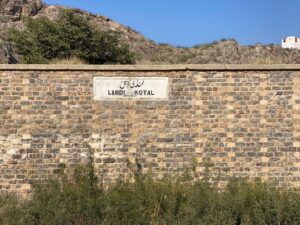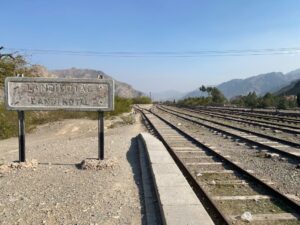Landi Kotal is a tehsil in the Khyber agency and the highest point of the Khyber Pass, close to the Pakistan-Afghanistan border at Torkham. On November 3, 1925, British administration devised a scheme to conduct a regular passenger/cargo service between Peshawar and Landi Kotal via the Khyber Pass. The main aim of this service was to aid local residents and soldiers deployed in the hilly regions. Victor Bailey was the engineer in charge of the line’s construction.

Its infrastructure was contrived by the British directorates in the early twentieth century, which required quick expeditious ingress to Afghanistan in the course of Great Game. The trajectory just progressed from Peshawar to Jamrud in 1920. However, by April 1926, the railway had been extended all the way to the Afghan border, serving as a vital and strategic link to enemy territory.
The train transported passengers across harsh mountain terrain, reaching a height of 1,200 meters (3,900 feet), on a 52-kilometer railway track that included 34 tunnels, 92 bridges and culverts, and 4 locomotive watering stops.
The Landi kotal station was constructed in a fortress like style. The intimidating facade facing the plot had no windows or entrances.

The lavish 1925 Landi Kotal railway station, with its water tanks, ticket office, and waiting rooms was nonetheless a testament to a bygone era’s magnificence. The track includes a few exceptional qualities. It would zigzag in through the landscape to gain altitude and arrives at its eventual destination: Landi kotal, from which one could travel into Afghanistan. However, its current state reflects the devastation. It’s the world’s only racetrack that goes through an airport (the runway of Bacha Khan International Airport of Peshawar).

The Khyber Train Safari (formerly known as the Khyber Steam Safari) was the country’s sole passenger train that still employs steam engines. It ran once a week on Friday between Peshawar and Landi Kotal that attracting hundreds of tourists. Vulcan Foundry and Kitson & Co in the United Kingdom manufactured the oil-fired steam engines that pushed and pulled the carriages from the back and front.
On the demand of the Afghan executive authorities, the Landi Kotal to Landi Khana stretch of railway was closed in 1932. Regular train service between Peshawar and Landi Kotal was maintained until 1982, when it was terminated and withdraw owing to a lack of commercial value and border turmoil.
One of the reason was that permission had to be certified from the airport authorities two or three days before the passing of the Khyber safari train.

That was another era. Floods in June 2006 and 2007 completely wrecked substantial sections of the railway track. After then, the authorities shut off the Safari service.Tourists weren’t the only ones who were benefitted from the busy rail route. Local employees utilized the train for Pak-Afghan commerce, because the Torkham border is only eight kilometers from the Landi Kotal railway station. This railway was a source of revenue for the Khyber Agency’s population.
Apart from the Peshawar to Khyber safari train, Pakistan Railways plans to build safari trains on several routes to promote the tourist business.